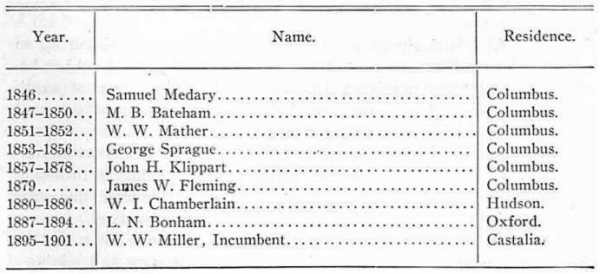|
THE Ohio State Board of Agriculture was created by an act of the General Assembly, passed February 27, 1846. The first officers of the board were ex-Governor Allen Trimble, President; Samuel Medary, Secretary; M. L. Sullivant, Treasurer. The first Ohio State Fair was held in Cincinnati, October 5-7, 1850, and a fair has been held each year since that time, except in 1888, when the Ohio Centennial took its place. From 1850 until 1874 the fair was held in the principal cities of the state, the city offering the greatest inducement, in the way of financial aid, securing it. In 1874 the board concluded to establish the fair permanently and centrally at the Capital of the State. The grounds of the Franklin County Agricultural Society (now Franklin Park), were rented until 1886, when the fair was held on grounds just north of the city, which the board had purchased three years previous and fitted up for this purpose. Exposition Park, which contains one hundred and fifteen acres, has been beautifully ornamented by lakes trees, shrubs, etc., and fine buildings have been erected for the various classes of exhibits, at a cost of several hundred thousand dollars. The live stock buildings are the largest and best in the country. The horse building is three hundred and thirty-two feet square and will accommodate over five hundred horses; and in addition to this, there are barns provided for speed and fancy horses. The cattle, sheep, and swine buildings are a little smaller than the horse building, but are similar to it in all details and have ample accommodations for immense exhibits. These structures are brick and stone, with slate roofs. Broad, clean walks extend through all the buildings, and visitors can, with comfort, view the animals in their stalls and pens. In 1880 the system of crop reporting was inaugurated by the board, with a corps of about eight hundred volunteer reporters, reports being made quarterly; since that time the number of correspondents has about doubled, the scope of the work has been enlarged and for a number of years the publication has been issued monthly. In 1881 a law was passed by the General Assembly charging the Secretary of the State Board of Agriculture with the duty of licensing the sale of commercial fertilizers in Ohio, and also sampling and analysing the same for publication. This work has been successfully pursued by the secretary with very satisfactory results both to consumers of commercial fertilizers and to manufacturers of same. The work has grown gradually, from small beginnings, until now a very large business is done and a considerable force is employed in the inspection, chemical analysis, etc., of fertilizers. In the winter of 1880-81 the board entered upon the work of holding farmers' institutes, and twenty-seven successful meetings were held that winter. The number increased gradually until 1889-90, when sixty-two meetings were held. During the winter of 1890 the General Assembly, recognizing the value of farmers' institutes to the agriculturists of the state, passed a law making liberal provision for their support, thus enabling the board to largely increase its work in this direction. In 1890-01 one hundred and twenty-four institutes were established by the board, and, during the institute season of 1900-01 about three hundred meetings were held. The Ohio State Board of Agriculture consists of ten members, two being elected each year for a period of five years. The office of the board is in the State House and is in charge of a Secretary and Assistant Secretary, who employ a stenographer, statistician, librarian, and a number of clerks. The Secretary is the head of the Department of Agriculture, which is a department of the State Government. The department has an extensive agricultural library of about seven thousand volumes, and through regular exchanges, receipt of government documents, gifts, purchases, etc., it is rapidly growing. These books and documents are available for reference to all who wish to use them. The following is a list of the Secretaries of the board, from its organization to date [1901]: 
|
Return to Early Institutions
Go to Main Page